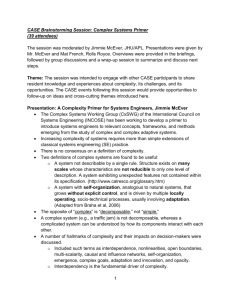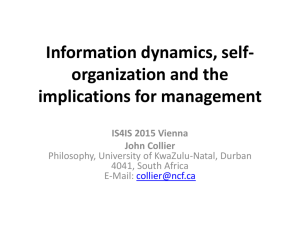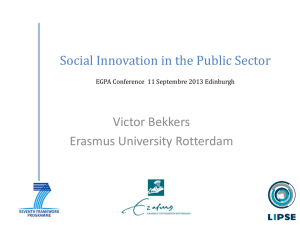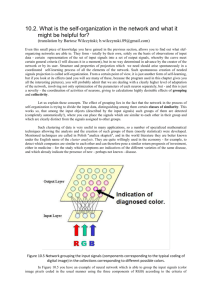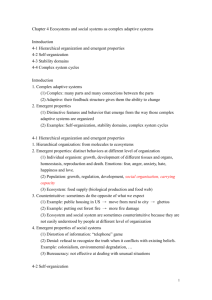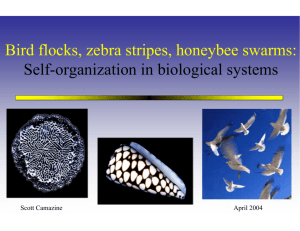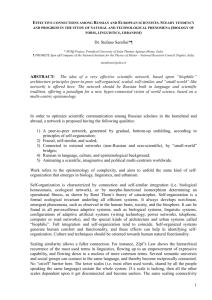Self-Organization for Nano-Computation and
advertisement
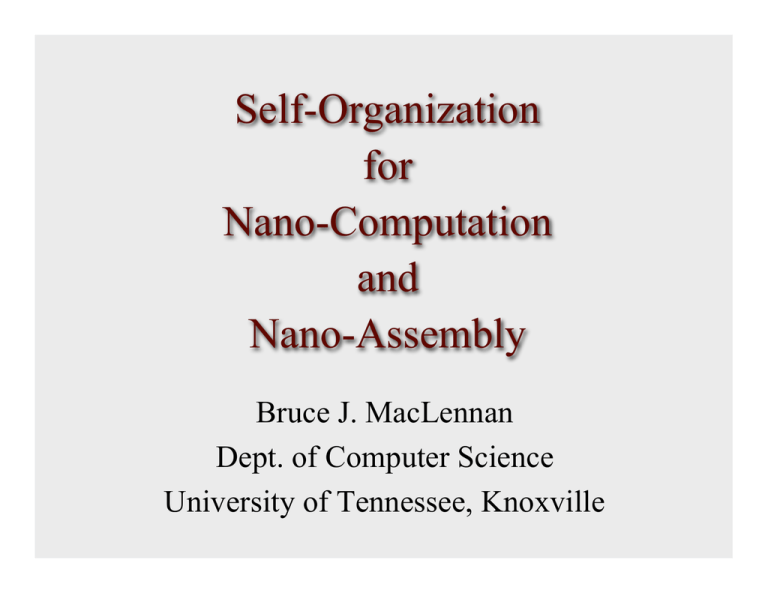
Self-Organization for Nano-Computation and Nano-Assembly Bruce J. MacLennan Dept. of Computer Science University of Tennessee, Knoxville Central Themes • Computation and physics – novel computational models to exploit novel technologies – computational control of matter formal material • Natural computation – computation occurring in nature, or – inspired by that occurring in nature 6 March 2007 Self-Organization for NanoComputation & Nano-Assembly 2 Current Research in Self-Organization • Synthetic Ethology & the Emergence of Communication • Molecular Computing for Nanostructure Synthesis & Control • Radical Reconfiguration of Computing Systems • Generalized Computation (U-Machine) • Programmable Microorganisms for Artificial Morphogenesis • Applications in Command, Control & Coordination 6 March 2007 Self-Organization for NanoComputation & Nano-Assembly 3 Some Principles of Adaptive Self-Organization • Positive & negative feedback • Noise, randomness, imperfection • Amplification of random fluctuations • Symmetry breaking • Diffusion • Stigmergy • Simple, local microdecisions 6 March 2007 • • • • • • Multiple interactions Circular causality Excitable media Local nonlinear interactions Adaptive stationary states Nonconvergence, diversity & suboptimal solutions • Developmental cascades • Entrainment & distributed synchronization Self-Organization for NanoComputation & Nano-Assembly 4 Synthetic Ethology and the Emergence of Communication Evolution of Communication (1990) • Experiments to demonstrate selforganized emergence of communication among simple agents • Selective pressure in favor of cooperation • Agents can modify or sense state of shared global environment • GA selects for best cooperators • Agents evolve to communicate using a simple code 6 March 2007 Self-Organization for NanoComputation & Nano-Assembly 6 The U-Machine 6 March 2007 Self-Organization for NanoComputation & Nano-Assembly 7 Computation in General Sense • A definition applicable to computation in nature as well as computers • Computation is a physical process, the purpose of which is abstract operation on abstract objects • A computation must be implemented by some physical system, but it may be implemented by any physical system with the appropriate abstract structure 6 March 2007 Self-Organization for NanoComputation & Nano-Assembly 8 Abstract Spaces • Should be general enough to include continuous & discrete spaces • Hypothesis: separable metric spaces • Include continua & countable discrete spaces • separable ⇒ approximating sequences 6 March 2007 Self-Organization for NanoComputation & Nano-Assembly 9 The U-Machine • Goal: a model of computation over abstract spaces that can be implemented in a variety of physical media • In particular, bulk nanostructured materials in which: – access to interior is limited – detailed control of structure is difficult – structural defects and other imperfections are unavoidable 6 March 2007 Self-Organization for NanoComputation & Nano-Assembly 10 Urysohn Embedding 6 March 2007 Self-Organization for NanoComputation & Nano-Assembly 11 Computation in Hilbert Space φ ( X,"X ) U ! ψ (Y,"Y ) (Z,"Z ) V ! f g " " Q ! [0,1] l Q p( m ) !fˆ ! 6 March 2007 [0,1] m p( n ) !gˆ ! Self-Organization for NanoComputation & Nano-Assembly ! ! " Q p( l ) ! W ! 12 ! ! [0,1] n ! An Abstract Cortex • Finite-dimensional representations of abstract spaces can be allocated disjoint regions in data space • Field representations can be allocated to separated regions • Analogous to regions in neural cortex 6 March 2007 Self-Organization for NanoComputation & Nano-Assembly 13 Decomposition of Computations • Complex computations may be decomposed into simpler ones • Variable regions provide interfaces between constituent computational processes • For maximum flexibility: don’t build in specific primitive processes • How are primitive processes implemented? 6 March 2007 Self-Organization for NanoComputation & Nano-Assembly 14 Implementation of Primitive Computations • There are several “universal approximation theorems” that make use of approximations of the form: H v = F (u) " # a j rj (u) j=1 • Works for a variety of simple nonlinear “basis functions” rj ! 6 March 2007 Self-Organization for NanoComputation & Nano-Assembly 15 (Re-)Configuration Methods 6 March 2007 Self-Organization for NanoComputation & Nano-Assembly 16 Overall Structure • Variable (data) space – Large number of scalar variables for Hilbert coefficients – Partitioned into regions representing abstract spaces • Function (program) space – Flexible interconnection (∴ 3D) – Programmable linear combinations – Application of basis functions 6 March 2007 Self-Organization for NanoComputation & Nano-Assembly 17 Depiction of UM Interior • Shell contains variable areas & computational elements • Interior filled with solid or liquid matrix (not shown) • Paths formed through or from matrix 6 March 2007 Self-Organization for NanoComputation & Nano-Assembly 18 Layers in Data Space • Connection matrix has programmable weights • Linear combinations are inputs to nonlinear basis functions • Exterior access to both sides for programming 6 March 2007 Self-Organization for NanoComputation & Nano-Assembly 19 Depiction of UM Exterior 6 March 2007 Self-Organization for NanoComputation & Nano-Assembly 20 Diffusion-Based Path Routing 6 March 2007 Self-Organization for NanoComputation & Nano-Assembly 21 Example of Path Routing • Starts and ends chosen randomly • Quiescent interval (for attractant decay) omitted from video • Each path occupies ~0.1% of space • Total: ~4% 6 March 2007 Self-Organization for NanoComputation & Nano-Assembly 22 Front 6 March 2007 Self-Organization for NanoComputation & Nano-Assembly 23 Right 6 March 2007 Self-Organization for NanoComputation & Nano-Assembly 24 Back 6 March 2007 Self-Organization for NanoComputation & Nano-Assembly 25 Left 6 March 2007 Self-Organization for NanoComputation & Nano-Assembly 26 Top 6 March 2007 Self-Organization for NanoComputation & Nano-Assembly 27 Bottom 6 March 2007 Self-Organization for NanoComputation & Nano-Assembly 28 Remarks • More realistic procedure: – Systematic placement of regions – Order of path growth – Control of diffusion & growth phases • General approach is robust (many variations work about as well) • Paths could be formed by: – Migration of molecules etc. – Change of state of immobile molecules 6 March 2007 Self-Organization for NanoComputation & Nano-Assembly 29 Example Connection-Growth Process • Goal: approximately full interconnection between incoming “axons” (A) and “dendrites” (D) of basis functions – Doesn’t have to be perfect • Each A & D periodically initiates fiber growth – Growth is approximately away from source • Fibers repel others of same kind – Diffusible, degradable repellant – Fibers follow decreasing gradient (in XZ plane) • Contact formed when A and D fibers meet 6 March 2007 Self-Organization for NanoComputation & Nano-Assembly 30 Example of Connection Formation • 10 random “axons” (red) and “dendrites” (blue) • Simulation stopped after 100 connections (yellow) formed 6 March 2007 Self-Organization for NanoComputation & Nano-Assembly 31 Resulting Connections 6 March 2007 Self-Organization for NanoComputation & Nano-Assembly 32 Summary of U-Machine • Permits computation on quite general abstract spaces (separable metric spaces) – Includes analog & digital computation • Computation by linear combinations & simple nonlinear basis functions • Simple computational medium can be reconfigured for different computations • Potentially implementable in a variety of materials 6 March 2007 Self-Organization for NanoComputation & Nano-Assembly 33 Computational (Re-)Configuration of Systems 6 March 2007 Self-Organization for NanoComputation & Nano-Assembly 34 “Radical Reconfiguration” • Ordinary reconfiguration changes connections among fixed components • Radical reconfiguration of transducers – to create new sensors & actuators • Radical reconfiguration of processors – to reallocate matter to different components • Also for repair & damage recovery • Requires rearrangement of atoms and molecules into new components • Requires “molar parallelism” 6 March 2007 Self-Organization for NanoComputation & Nano-Assembly 35 Computational Control of Matter • A material process may be used as a substrate for formal computation • Formal computation may be used to control a material process • A material process may be a substrate for universal computation, controlled by a formal program • A formal program may be used to govern a material process 6 March 2007 Self-Organization for NanoComputation & Nano-Assembly 36 The Physical State as Synthetic Medium • Computation controls physical state (as synthesis medium) • Reconfigured computer is embodied in physical state • Computation must be able to distinguish synthetically relevant physical states 6 March 2007 Self-Organization for NanoComputation & Nano-Assembly 37 Universal Computer external input U (equations) physical state synthesis medium 6 March 2007 Self-Organization for NanoComputation & Nano-Assembly 38 Initialization δ external input 6 March 2007 d U s Self-Organization for NanoComputation & Nano-Assembly 39 Computation waste external input d′ U s′ energy 6 March 2007 Self-Organization for NanoComputation & Nano-Assembly 40 Completion external input U C synthesized computer 6 March 2007 Self-Organization for NanoComputation & Nano-Assembly 41 Equilibrium vs. Stationary Configurations • Program terminates for equilibrium config. • Program continues to run for stationary config. input U waste input′ d′ U d′′ C′ C energy 6 March 2007 Self-Organization for NanoComputation & Nano-Assembly 42 Thermodynamics of a Configuration • Either, configuration is a stable state – damage may shift to undesirable equilibrium • Or, configuration is a stationary state of a non-equilibrium system – continuously reconfigures self – self-repair as return to original stationary state – adaptation & damage recovery as move to different stationary state 6 March 2007 Self-Organization for NanoComputation & Nano-Assembly 43 Useful Media for Computational Synthesis • For pure computation, move as little matter & energy as possible • For synthesis, need to control atoms & molecules as well as electrons • Need sufficiently wide variety of controllable atoms & molecules • Goal: structures on the order of optical wavelengths (100s of nm) 6 March 2007 Self-Organization for NanoComputation & Nano-Assembly 44 Models of Computation for Synthesis • Need massive parallelism to control detailed organization of state • Need tolerance to errors in state – synthesis program should be tolerant – configured computer should be tolerant 6 March 2007 Self-Organization for NanoComputation & Nano-Assembly 45 Locus of Control of Detailed Organization • Reorganizing atoms & molecules ⇒ vast amount of detailed control • Heterosynthesis – external configuration controller determines fine structure of medium (high bandwidth) • Autosynthesis – external configuration controller determines general boundary conditions (low BW) – fine structure results from self-organization 6 March 2007 Self-Organization for NanoComputation & Nano-Assembly 46 General Model of Radical Reconfiguration • Synthesis controller – low bandwidth to outside world – bandwidth to medium: • high for heterosynthesis • low for autosynthesis • Synthetic medium – molar parallelism of interactions • simple for heterosynthesis • complex for autosynthesis – what are suitable synthetic media? 6 March 2007 Self-Organization for NanoComputation & Nano-Assembly 47 Simple Example: Reaction-Diffusion System • Many natural patterns can be explained by reactiondiffusion equations • ∂c / ∂t = D∇2c + F(c) • where c is a vector of concentrations, and D is a diagonal matrix of diffusion rates, and F is a nonlinear vector function photos ©2000, S. Cazamine 6 March 2007 Self-Organization for NanoComputation & Nano-Assembly 48 Example: Activation-Inhibition System • Let σ be the logistic sigmoid function • Activator A and inhibitor I may diffuse at different rates in x and y directions • Cell is “on” if activator + bias exceeds inhibitor "A "2A "2A = dAx 2 + dAy 2 + k A# [ mA ( A + B $ I )] "t "x "y "I " 2I " 2I = dIx 2 + dIy 2 + k I# [ mI ( A + B $ I )] "t "x "y 6 March 2007 Self-Organization for NanoComputation & Nano-Assembly 49 Double Activation-Inhibition System • Two independently diffusing activation-inhibition pairs • May have different diffusion rates in X and Y directions – In this example, I1y >> I1x and I2x >> I2y • Colors in simulation: – – – – green = system 1 active red = system 2 active yellow = both active black = neither active 6 March 2007 Self-Organization for NanoComputation & Nano-Assembly 50 Formation of Pattern • Random initial state • System stabilizes to < 1% cell changes • Modest noise (annealing noise) improves regularity 6 March 2007 Self-Organization for NanoComputation & Nano-Assembly 51 Stationary State • System is being continually maintained in a stationary state • Continuing change < 1% 6 March 2007 Self-Organization for NanoComputation & Nano-Assembly 52 Recovery from Damage • Simulated damage • Damage destroys activators & inhibitors as well as structure • System repairs self by returning to stationary state • No explicit repair signal 6 March 2007 Self-Organization for NanoComputation & Nano-Assembly 53 Reconfiguration: Orthogonal Structure • Exchange inhibitor diffusion rates for systems 1 & 2 • Vertical stripes become horizontal • Horizontal stripes become vertical • No explicit reconfiguration signal 6 March 2007 Self-Organization for NanoComputation & Nano-Assembly 54 Summary of Radical Reconfiguration • Computation can be used to rearrange matter • External control of initial and boundary conditions • Detailed structure by self-organization with molar parallelism • Stationary states can be used for self-repair and adaptation 6 March 2007 Self-Organization for NanoComputation & Nano-Assembly 55 Programmable Microorganisms for Artificial Morphogenesis Artificial Morphogenesis • Based on models of embryological development • Cells migrate by local interaction & chemical signals • Possible implementation: “programmable” micro-organisms 6 March 2007 Self-Organization for NanoComputation & Nano-Assembly 57 Why Micro-Organisms? • Micro-organisms can be viewed a micro-robots with capabilities for: – – – – – – – – – locomotion sensing control simple (low-precision analog) computation assembly collective, coordinated behavior reproduction self-defense metabolism (matter/energy acquisition, growth, repair) • Can be genetically-engineered for our purposes 6 March 2007 Self-Organization for NanoComputation & Nano-Assembly 58 The Programmable Microorganism (“Promorg”) • Noncoding DNA can be used for “genetic circuits” – in eukaryotes, 10–70% – equivalent of about 3000 genes in yeast • Equipped with an assortment of generally useful sensors & receptors (especially for selforganization) • Special-purpose modifications for particular applications • Research: principles of design & self-organization 6 March 2007 Self-Organization for NanoComputation & Nano-Assembly 59 Tentative Capabilities • Neutral proteins for programmable control – gene regulatory & coding sequences – connections can be regulated by external signals • Membrane & cytoplasm receptors for: – chemical signals – light, etc. • Effectors – – – – cilia for locomotion cell adhesion exocytosis programmed cell death 6 March 2007 Self-Organization for NanoComputation & Nano-Assembly 60 Simulation of Self-Organized Aggregation & Protective Differentiation of Simple Autonomous Agents Goal • Adverse conditions aggregate into dense colonies • Differentiate into outer “boundary” and inner “interior” cells • Interior cells become dormant until favorable conditions return • Boundary cells secrete protective cyst material and die • When favorable conditions return, dormant cells reanimate and break out of protective case 6 March 2007 Self-Organization for NanoComputation & Nano-Assembly 62 Control Diagram for Cells 6 March 2007 Self-Organization for NanoComputation & Nano-Assembly 63 Normal State • Organisms wander • & reproduce • Until some environmental condition (“temperature”) becomes unfavorable 6 March 2007 Self-Organization for NanoComputation & Nano-Assembly 64 Distressed State • Distressed cells emit Distress signal (red) • If concentration exceeds quorum threshold, cells climb gradient • Concentration of distress signal shown in red 6 March 2007 Self-Organization for NanoComputation & Nano-Assembly 65 Aggregated State • Cells in contact emit Aggregated signal (green) • If concentration is above Boundary threshold, cell enters Interior state (purple) • Else remains in Boundary state (green) 6 March 2007 Self-Organization for NanoComputation & Nano-Assembly 66 Dormant State • When Distress signal exceeds signaling threshold: • Cell emits rapidly diffusing Sporeformation signal (magenta) • Interior cells enter dormant state (blue) • Boundary cells form cysts (grey) & die 6 March 2007 Self-Organization for NanoComputation & Nano-Assembly 67 Return of Favorable Conditions • Surviving cells reanimate • Destroy cyst material • Return to Normal state 6 March 2007 Self-Organization for NanoComputation & Nano-Assembly 68 Conclusions • Demonstrates useful collective behavior based on: – simple control mechanisms – diffusible chemical signals • Quorum sensing & aggregation of cells • Differentiation of function • Assembly of a simple protective structure 6 March 2007 Self-Organization for NanoComputation & Nano-Assembly 69 Molecular Combinatory Computing for Nanostructure Synthesis & Control Supported by NSF Nanoscale Exploratory Research Grant skip 6 March 2007 Self-Organization for NanoComputation & Nano-Assembly 70 Definition • Intelligent Matter – a material in which individual molecules or supramolecular clusters function as agents to accomplish a purpose • Programmable Intelligent Matter – a program controls the behavior of the material at the molecular level • Universally Programmable Intelligent Matter – small set of molecular building blocks that can be rearranged to accomplish any purpose describable by a computer program – power of Universal Turing Machine 6 March 2007 Self-Organization for NanoComputation & Nano-Assembly 71 Non-Traditional Models of Computation • Need to explore non-traditional models of computation more closely matched to physical processes • Discrete (digital) computation • Continuous (analog) computation • Hybrid computation 6 March 2007 Self-Organization for NanoComputation & Nano-Assembly 72 Continuous (Analog) Computation • Exploit continuous physical processes for computation • Need to identify small set of widely useful systems of DEs & PDEs • Research in universal analog computers is relevant • Field computation 6 March 2007 Self-Organization for NanoComputation & Nano-Assembly 73 Discrete (Digital) Computation • Alternatives to Boolean logic • Need information representation more closely matched to molecular & submolecular structures • Need elementary operations more closely matched to molecular & sub-molecular processes 6 March 2007 Self-Organization for NanoComputation & Nano-Assembly 74 Alternative Models of Discrete Computation • Many Turing-equivalent models were developed in the early 20th century – e.g., Post productions, Markov algorithms, lambda calculus, combinatory logic, McCulloch-Pitts cells • Cellular Automata are promising – need to be universal in a relevant way 6 March 2007 Self-Organization for NanoComputation & Nano-Assembly 75 Molecular Combinatory Computing • Systematic approach to nanotechnology based on small set of MBBs • Combinatory logic • Computational universality from two substitutions (+ a few more) • Substitutions may be done in any order or in parallel 6 March 2007 Self-Organization for NanoComputation & Nano-Assembly 76 K-Substitution ((K X) Y) ⇒ X 6 March 2007 Self-Organization for NanoComputation & Nano-Assembly 77 S-Substitutions (((S X) Y) Z) ⇒ ((X Z) (Y Z′)) 6 March 2007 Self-Organization for NanoComputation & Nano-Assembly 78 Ý-Substitution (Ý F) ⇒ y(1) 6 March 2007 where y ≡ (F y(0)) Self-Organization for NanoComputation & Nano-Assembly 79 Example of Simple Computation ((S(KS)K)S) ⇒ (((KS)S)(KS)) 6 March 2007 Self-Organization for NanoComputation & Nano-Assembly 80 Example of Simple Computation ((KS)S) ⇒ S 6 March 2007 Self-Organization for NanoComputation & Nano-Assembly 81 Example of Simple Computation (((S(KS)K)K) ⇒ (((KS)K)(KK)) 6 March 2007 Self-Organization for NanoComputation & Nano-Assembly 82 Example of Simple Computation ((KS)K) ⇒ S 6 March 2007 Self-Organization for NanoComputation & Nano-Assembly 83 Example of Simple Computation result = (S(KK)) 6 March 2007 Self-Organization for NanoComputation & Nano-Assembly 84 Example: Nanotube Visualization of nanotube produced by ptube5,4 6 March 2007 Self-Organization for NanoComputation & Nano-Assembly 85 Example: Nanotube 6 March 2007 Self-Organization for NanoComputation & Nano-Assembly 86 In Functional Programming Language let prib(m) = compose (polyextend shared-formalize m) rib where rib = polyextend compose m cycle (reduce permute m identity) in let ptube(m, n) = iterate n prib(m) in ptube(5, 4) 6 March 2007 Self-Organization for NanoComputation & Nano-Assembly 87 Reduced to SKY Tree (((S ((S (K S)) K)) ((S ((S (K S)) K)) ((S ((S (K S)) K)) ((S ((S (K S)) K)) (K ((S K) K)))))) ((((S ((((S (K S)) K) ((S (K S)) K)) S)) (K K)) ((((S (K S)) K) S) (((S (K S)) K) ((((S (K S)) K) S) (((S (K S)) K) ((((S (K S)) K) S) (((S (K S)) K) ((((S (K S)) K) S) (((S (K S)) K) S))))))))) ((((((S (K S)) K) ((S (K S)) K)) ((((S (K S)) K) ((S (K S)) K)) ((((S (K S)) K) ((S (K S)) K)) ((((S (K S)) K) ((S (K S)) K)) ((S (K S)) K))))) Y) (((((S (K S)) K) (((S (K S)) K) ((((S (K S)) K) (((S (K S)) K) ((((S (K S)) K) (((S (K S)) K) ((((S (K S)) K) (((S (K S)) K) ((S ((((S (K S)) K) ((S (K S)) K)) S)) (K K)))) ((S ((((S (K S)) K) ((S (K S)) K)) S)) (K K))))) ((S ((((S (K S)) K) ((S (K S)) K)) S)) (K K))))) ((S ((((S (K S)) K) ((S (K S)) K)) S)) (K K))))) ((S ((((S (K S)) K) ((S (K S)) K)) S)) (K K))) ((S K) K))))) 6 March 2007 Self-Organization for NanoComputation & Nano-Assembly 88 Linearized for Chemical Synthesis & Replication PPPS PPS PK SQQ KQQ PPS PPS PK SQQ KQQ PPS PPS PK SQQ KQQ PPS PPS PK SQQ KQQ PK PPS KQ KQQQQQQ PPPPS PPPPS PK SQQ KQ PPS PK SQQ KQQ SQQ PK KQQ PPPPS PK SQQ KQ SQ PPPS PK SQQ KQ PPPPS PK SQQ KQ SQ PPPS PK SQQ KQ PPPPS PK SQQ KQ SQ PPPS PK SQQ KQ PPPPS PK SQQ KQ SQ PPPS PK SQQ KQ SQQQQQQQQQ PPPPPPS PK SQQ KQ PPS PK SQQ KQQ PPPPS PK SQQ KQ PPS PK SQQ KQQ PPPPS PK SQQ KQ PPS PK SQQ KQQ PPPPS PK SQQ KQ PPS PK SQQ KQQ PPS PK SQQ KQQQQQ YQ PPPPPS PK SQQ KQ PPPS PK SQQ KQ PPPPS PK SQQ KQ PPPS PK SQQ KQ PPPPS PK SQQ KQ PPPS PK SQQ KQ PPPPS PK SQQ KQ PPPS PK SQQ KQ PPS PPPPS PK SQQ KQ PPS PK SQQ KQQ SQQ PK KQQQQ PPS PPPPS PK SQQ KQ PPS PK SQQ KQQ SQQ PK KQQQQQ PPS PPPPS PK SQQ KQ PPS PK SQQ KQQ SQQ PK KQQQQQ PPS PPPPS PK SQQ KQ PPS PK SQQ KQQ SQQ PK KQQQQQ PPS PPPPS PK SQQ KQ PPS PK SQQ KQQ SQQ PK KQQQ PPS KQ KQQQQQ 6 March 2007 Self-Organization for NanoComputation & Nano-Assembly 89 Molecular Computation 6 March 2007 Self-Organization for NanoComputation & Nano-Assembly 90 Cross-Linked Membrane Visualization of membrane produced by xgrid3,4 NNN 6 March 2007 Self-Organization for NanoComputation & Nano-Assembly 91 Cross-linked Membrane 6 March 2007 Self-Organization for NanoComputation & Nano-Assembly 92 Hexagonal Membrane Produced by hgridt2,3 N Arown = BW[n-1]°B[n] Vrown = W[n]°KI°K(2n-2)° B[n-1]°C[n]IN°CIN drowtn = Vrowtn°Arown hgridtm,n = Zn-1W(ZmdrowtnN) 6 March 2007 Self-Organization for NanoComputation & Nano-Assembly 93 Possible Molecular Implementation • Covalently-structured MBBs for nodes and linking groups • H-bonds for interconnections • H-bonds for identification • Synthetic components appended • Substitutions controlled by enzyme-like covalently-structured molecules 6 March 2007 Self-Organization for NanoComputation & Nano-Assembly 94 Progress to Date • Simulation & theoretical studies: – ways of assembling hierarchical heterogeneous structures from patches – membranes, pores, sensor interface, one-shot channels, simple actuators, nanotubes • In progress: – recyclable channels, cilia, rotary motion – molecular implementations (including DNA) 6 March 2007 Self-Organization for NanoComputation & Nano-Assembly 95 Summary of MCC • Concept of molecular combinatory computing – molecular networks self-organize by simple substitution reactions – computationally universal • Simulated synthesis applications • Synthesis of large, heterogeneous structures • Possible molecular implementation based on Hbonded, covalently-structured building blocks 6 March 2007 Self-Organization for NanoComputation & Nano-Assembly 96 Applications in Command, Control & Coordination Potential Application Domains • Robots & autonomous vehicles – contemporary robots & AVs – microrobots – nanobots • Informational agents • Command, control & coordination of human agents 6 March 2007 Allocation of resources Exploration vs. exploitation Communication Distributed synchronization Information storage Construction Self-Organization for NanoComputation & Nano-Assembly 98 Conclusions • Computation can be used to control matter – for reconfiguration of computers, transducers, etc. – for nano-assembly and control • Detailed structure determined by self-organization • Natural systems provide good models and possible implementation technologies • Artificial systems with the robustness of natural systems should be achievable • For more information: www.cs.utk.edu/~mclennan 6 March 2007 Self-Organization for NanoComputation & Nano-Assembly 99
